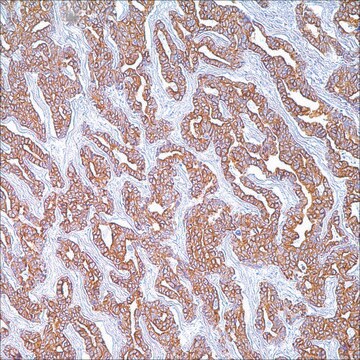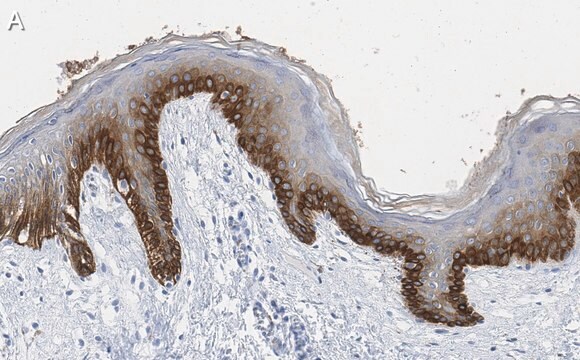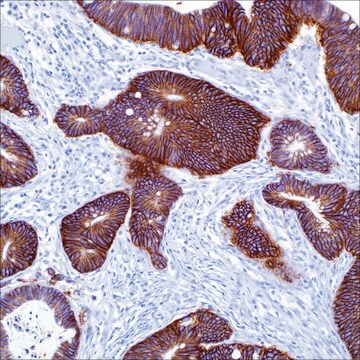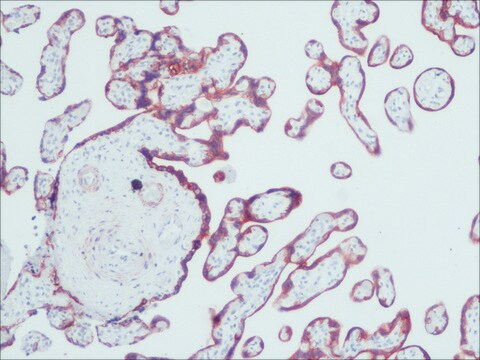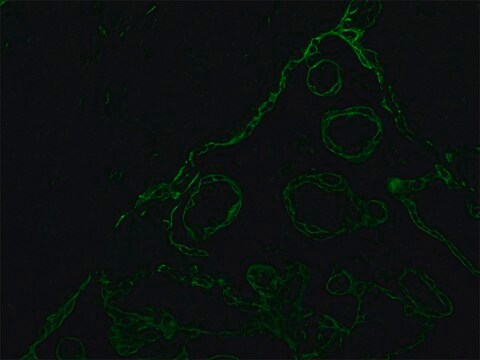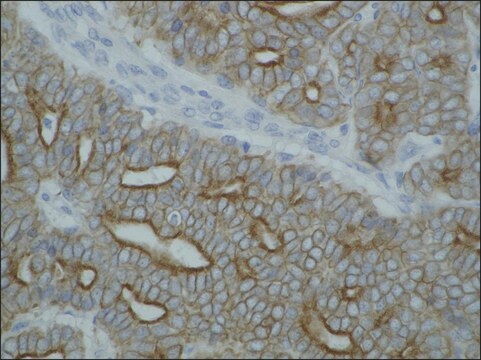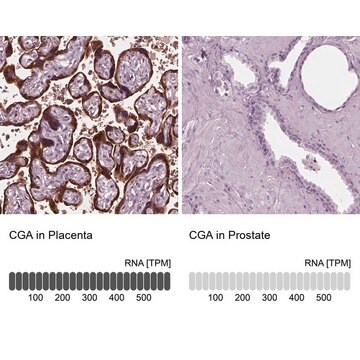MAB3412
Anti-Cytokeratin AE1/AE3 Antibody, recognizes acidic & basic cytokeratins, clone AE1/AE3
clone AE1/AE3, Chemicon®, from mouse
Recommended Products
biological source
mouse
Quality Level
antibody form
purified antibody
antibody product type
primary antibodies
clone
AE1/AE3, monoclonal
species reactivity
chicken, mouse, monkey, human, rabbit, bovine, rat
manufacturer/tradename
Chemicon®
technique(s)
ELISA: suitable
immunohistochemistry: suitable
western blot: suitable
isotype
IgG1
shipped in
wet ice
Gene Information
bovine ... Krt1(100301161)
human ... KRT1(3848)
mouse ... Krt1(16678)
rat ... Krt1(300250)
General description
Specificity
Immunogen
Application
A previous lot of this antibody was used for ELISA (Woodcock-Mitchel & Sun, 1982).
Western blot:
(Woodcock-Mitchel & Sun, 1982; Tseng et al., 1982; Laster et al., 1986) ELISA: (Woodcock-Mictchel & Sun, 1982)
Immunohistochemistry(paraffin):
0.5-2 µg/mL of a previous lot was used on staining of unfixed frozen or formalin -fixed, paraffin-embedded tissue section (Woodcock-Mitchel & Sun, 1982; Tseng et al., 1982; Asch * Asch, 1986; Rodriguez et al., 1986; Clausen et al., 1986; Klein-Szanto et al., 1987; Reibel et al., 1985). Trypsin or pepsin digestion is required for proper staining on paraffin embedded tissues. {Trypsin 1 mg/mL 10 minutes, 37°C, or pepsin 1 mg/mL 5 minutes 37°C}. High temperature with citrate antigen retrieval can also be used.
Optimal dilutions must be determined by end user.
Cell Structure
Cytokeratins
Quality
Western blot:
1:500 dilution of this lot detected CYTOKERATIN AE1/AE3 on 10 μg of A431 lysates.
Target description
Physical form
Storage and Stability
DO NOT FREEZE.
Analysis Note
All epithelium-derived tissues & tumors
Other Notes
Legal Information
Disclaimer
Signal Word
Danger
Hazard Statements
Precautionary Statements
Hazard Classifications
Repr. 1B
Storage Class Code
6.1D - Non-combustible, acute toxic Cat.3 / toxic hazardous materials or hazardous materials causing chronic effects
WGK
WGK 1
Flash Point(F)
Not applicable
Flash Point(C)
Not applicable
Certificates of Analysis (COA)
Search for Certificates of Analysis (COA) by entering the products Lot/Batch Number. Lot and Batch Numbers can be found on a product’s label following the words ‘Lot’ or ‘Batch’.
Already Own This Product?
Documents related to the products that you have purchased in the past have been gathered in the Document Library for your convenience.
Difficulty Finding Your Product Or Lot/Batch Number?
How to Find the Product Number
Product numbers are combined with Pack Sizes/Quantity when displayed on the website (example: T1503-25G). Please make sure you enter ONLY the product number in the Product Number field (example: T1503).
Example:
Additional examples:
705578-5MG-PW
PL860-CGA/SHF-1EA
MMYOMAG-74K-13
1000309185
enter as 1.000309185)
Having trouble? Feel free to contact Technical Service for assistance.
How to Find a Lot/Batch Number for COA
Lot and Batch Numbers can be found on a product's label following the words 'Lot' or 'Batch'.
Aldrich Products
For a lot number such as TO09019TO, enter it as 09019TO (without the first two letters 'TO').
For a lot number with a filling-code such as 05427ES-021, enter it as 05427ES (without the filling-code '-021').
For a lot number with a filling-code such as STBB0728K9, enter it as STBB0728 without the filling-code 'K9'.
Not Finding What You Are Looking For?
In some cases, a COA may not be available online. If your search was unable to find the COA you can request one.
Articles
16HBE14o- human bronchial epithelial cells used to model respiratory epithelium for the research of cystic fibrosis, viral pulmonary pathology (SARS-CoV), asthma, COPD, effects of smoking and air pollution. See over 5k publications.
Our team of scientists has experience in all areas of research including Life Science, Material Science, Chemical Synthesis, Chromatography, Analytical and many others.
Contact Technical Service